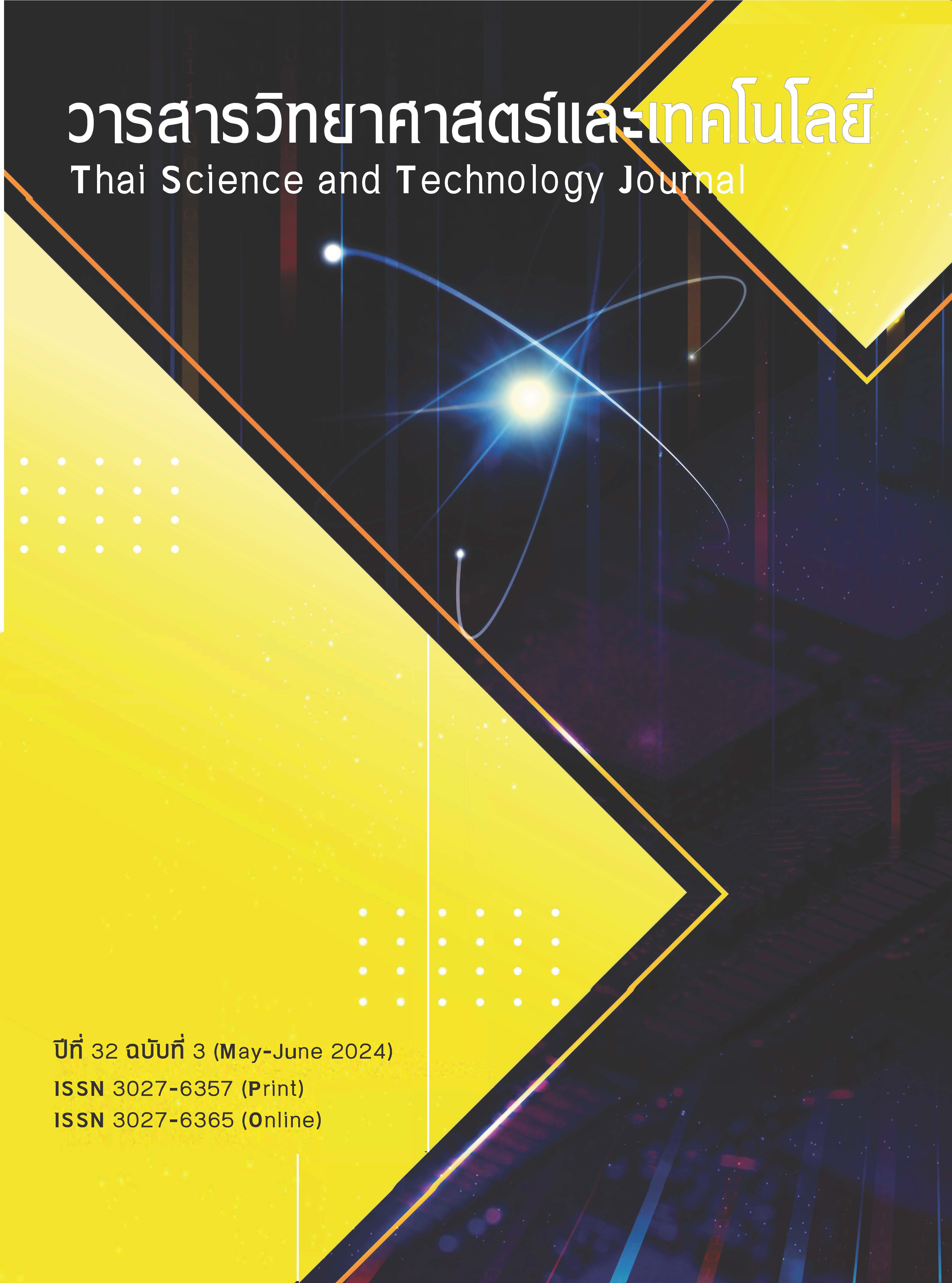Cannabinoids Extraction from Cannabis Cultivar Blueberry by Pulsed Electric Field
Main Article Content
Abstract
The aims of this study were to define the optimum conditions for pulsed electric field extraction of delta-9-tetrahydrocannabinol (THC) and total cannabinoids of the Cannabis sativa L. (Blueberry variety) and to apply the response surface method to design a Box Behnken experiment to investigate the effects of three independent variables: pulse numbers at levels 100-300, pulse intensity at 5-10 kV/cm, and the solution ratio at 1:20-1:40. The best yield result was then compared with the traditional maceration extraction method. The experiments found that the optimum conditions for extracting THC and total cannabinoids were 300 pulses, a pulse intensity of 7.5 kV/cm, and a solution ratio of 1:20. The maximum THC content was 254.77±11.01 mg/g, and the total cannabinoids content was 270.98±11.96 mg/g, which were higher than those obtained by maceration by 20.13% and 22.69%, respectively. Moreover, the extraction time was significantly shorter, by 88.9%. Therefore, the extraction of cannabinoids using the pulsed electric field technique can be an effective method for extracting high-value phytochemicals from cannabis, offering both efficiency and higher quality.
Article Details
References
D.T. Brown, Cannabis The Genus Cannabis, harwood academic publishers, 1998.
D. Jin, K. Dai, Z. Xie, J. Chen, Secondary Metabolites Profiled in Cannabis Inflorescences, Leaves, Stem Barks, and Roots for Medicinal Purposes, Sci Rep. 10 (2020). https://doi.org/10.1038/s41598-020-60172-6.
M. Woodbridge, Bedrocan International. (2019) 53.
J. Azmir, I.S.M. Zaidul, M.M. Rahman, K.M. Sharif, A. Mohamed, F. Sahena, M.H.A. Jahurul, K. Ghafoor, N.A.N. Norulaini, A.K.M. Omar, Techniques for extraction of bioactive compounds from plant materials: A review, J Food Eng. 117 (2013) 426–436. https://doi.org/10.1016/j.jfoodeng.2013.01.014.
L.G. Yan, L. He, J. Xi, High intensity pulsed electric field as an innovative technique for extraction of bioactive compounds—A review, Crit Rev Food Sci Nutr. 57 (2017) 2877–2888. https://doi.org/10.1080/10408398.2015.1077193.
A. Haji-Moradkhani, R. Rezaei, M. Moghimi, Optimization of pulsed electric field-assisted oil extraction from cannabis seeds, J Food Process Eng. 42 (2019). https://doi.org/10.1111/jfpe.13028.
R. Bobinaite, G. Pataro, N. Lamanauskas, S. Šatkauskas, P. Viškelis, G. Ferrari, Application of pulsed electric field in the production of juice and extraction of bioactive compounds from blueberry fruits and their by-products, J Food Sci Technol. 52 (2015) 5898–5905. https://doi.org/10.1007/s13197-014-1668-0.
L.S. Zaharia, I. Trofin, D.-I. Vaireanu, G. Dabija, INFLUENCE OF TEMPERATURE AND HEATING TIME ON THE DECARBOXYLATION OF Δ 9-THCA AND CBDA IN THE CANNABIS INFLORESCENCES, Bull., Series B. 82 (2020) 2020.
R. Jintawiwat, N. Punamorntarakul, R. Hirunyasiri, P. Jarupoom, T. Pankasemsuk, S. Supasin, A. Kawee-ai, Article Testing of a Prototype Combining Ultrasound and Pulsed 3 Electric Field on Extracted Valuable Compounds of Mitragyna 4 speciosa Leaves, 5 (2023). https://doi.org/10.3390/xxxxx.
J.C. Weaver, Electroporation Theory Concepts and Mechanisms, 1995. https://doi.org/10.1385/0-89603-328-7:3
M.M.A.N. Ranjha, R. Kanwal, B. Shafique, R.N. Arshad, S. Irfan, M. Kieliszek, P.Ł. Kowalczewski, M. Irfan, M.Z. Khalid, U. Roobab, R.M. Aadil, A critical review on pulsed electric field: A novel technology for the extraction of phytoconstituents, Molecules. 26 (2021). https://doi.org/10.3390/molecules26164893.
C.L. Ramirez, M.A. Fanovich, M.S. Churio, Cannabinoids: Extraction Methods, Analysis, and Physicochemical Characterization, in: Studies in Natural Products Chemistry, Elsevier B.V., 2018: pp. 143–173. https://doi.org/10.1016/B978-0-444-64183-0.00004-X.


